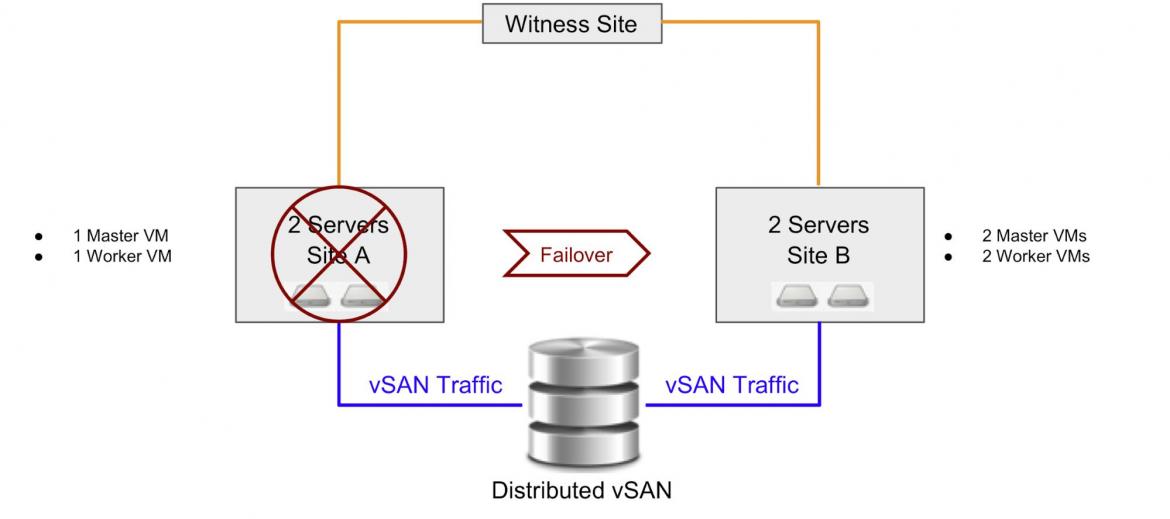table { border: #ddd solid 1px; } td, th { padding: 8px; border: #ddd solid 1px; } td p { font-size: 15px !important; }
Storage reliability plays a critical role in managing business-critical applications. A reliable storage solution can help enterprises avoid unnecessary downtime.
With Red Hat OpenShift Container Storage continuing to evolve, it became time to verify, in situ, the combined reliability of OpenShift Container Storage and Red Hat OpenShift Container Platform when it comes to high availability (HA) in a hardware configuration supported out of the box (mentioned in the Red Hat OpenShift Container Storage Planning Guide).
And so we did.
Physical layout for benchmarking
The physical layout we chose for benchmarking included:
Software
-
VMWare vSphere 6.7.0.44000
-
OpenShift Container Platform 4.4.3 on the server side
-
OpenShift Container Platform 4.4.7 on the client side
-
OpenShift Container Storage 4.4.0
-
Red Hat Ansible Automation Platform 2.9 for automated UPI deployment
Hardware
-
Two physical sites (Site A and Site B)
-
2 physical servers on Site A
-
2 physical servers on Site B
-
-
One witness site (Site C)
-
1 physical server
-
-
10GbE network connectivity between site
-
Distributed vSAN configuration
-
vSAN Default Storage Policy
-
Accessible from Site A
-
Accessible from Site B
-
Active workloads during test
It was important to configure the environment so that some storage activity would occur permanently while allowing verification that some key components of the Red Hat OpenShift Platform infrastructure would remain operational. To do so, we configured the following parameters and workload in the environment:
-
The monitoring and alerting solution was configured to use OpenShift Container Storage.
-
ocs-storagecluster-ceph-rbd storage class
-
-
The Openshift Container Platform internal registry was configured to use OpenShift Container Storage.
-
ocs-storagecluster-cephfs storage class
-
-
S3 workload continuously running (OBC).
-
openshift-storage.noobaa.io storage class.
-
-
Block workload continuously running (RWO PVC)
-
ocs-storagecluster-ceph-rbd storage class.
-
-
File based workload continuously running (RWX PVC).
-
ocs-storagecluster-cephfs storage class
-
The following schematic illustrates the infrastructure used during our benchmark.

We performed active/passive and active/active site configuration tests.
Active/passive site configuration
Test 1
The first test entailed deploying all the virtual machines (VMs) of the Red Hat OpenShift Platform clusters, consisting of three master nodes and three worker nodes, in an active/passive configuration as far as vCenter is concerned. All the Openshift Container Platform VMs were abruptly isolated by shutting down all network ports on the physical servers at the switch level. This resulted in the following critical condition:
-
The witness site lost contact with all the vSphere nodes on Site A.
-
All pods running on all Openshift Container Platform nodes lost contact with each other.
After about 30 seconds, vCenter reported the critical condition and initiated a failover of all the VMs on the surviving physical nodes on the second site. The following diagram depicts the test scenario.

Once vCenter detected the loss of the two physical nodes on the failed site, it initiated the failover of all the VMs on the surviving site. The six virtual machines were restarted in less than 10 minutes.
Active/active site configuration
Test 1
The first test consisted of deploying three VMs on one site (master nodes) and three VMs on the other site (worker nodes) in an active/active configuration as far as vCenter is concerned. All the worker node VMs were abruptly isolated by shutting down all network ports on the physical servers at the switch level. This resulted in the following critical condition:
-
The witness site lost contact with all the vSphere nodes on Site A.
-
All pods running on the Openshift Container Platform worker nodes lost contact with each other.
-
All Openshift Container Platform master nodes lost contact with the Openshift Container Platform worker nodes.
After about 30 seconds, vCenter reported the critical condition and initiated a failover of all the VMs on the surviving physical nodes on the second site. The following diagram depicts the test scenario.

Once vCenter detected the loss of the two physical nodes on the failed site, it initiated the failover of all the VMs on the surviving site. The three VMs were restarted, and the entire cluster was operational in under 10 minutes.
Test 2
The second test consisted of deploying two VMs on one site (one master node and one worker node) and four VMs on the other site (two master nodes and two worker nodes) in an active/active configuration as far as vCenter is concerned. The two physical servers of the site running one master node and one worker node were abruptly isolated by shutting down all network ports on the physical servers at the switch level. This resulted in the following critical condition:
-
The witness site lost contact with all the vSphere nodes on Site A.
-
Two Openshift Container Platform nodes, one master and one worker, were disconnected from the Openshift Container Platform cluster.
After about 30 seconds, vCenter reported the critical condition and initiated a failover of all the VMs on the surviving physical nodes on the second site. This diagram depicts the test scenario.

Once vCenter detected the loss of the two physical nodes on the failed site, it initiated the failover of all VMs on the surviving site. The two VMs were restarted and the cluster was operational in under 10 minutes.
Test 3
The third test consisted of deploying four VMs on one site (two master nodes and two worker nodes) and two VMs on the other site (one master node and one worker node) in an active/active configuration as far as vCenter is concerned. The two physical servers of the site running two master node and two worker node VMs were abruptly isolated by shutting down all network ports on the physical servers at the switch level. This resulted in the following critical condition:
-
The witness site lost contact with all the vSphere nodes on Site A.
-
Four Openshift Container Platform nodes, two masters and two workers, were disconnected from the Openshift Container Platform cluster.
After about 30 seconds, vCenter reported the critical condition and initiated a failover of all the VMs on the surviving physical nodes on the second site. This diagram depicts the test scenario.

Once vCenter detected the loss of the two physical nodes on the failed site, it initiated the failover of all the VMs on the surviving site. The four VMs were restarted, and the entire cluster was operational in under 10 minutes.
Summary
In every test scenario we tried, the OpenShift Container Platform environment and the OpenShift Container Storage environment were restored to operational condition in less than 10 minutes. This table summarizes the tests that were performed.
|
Site A |
Site B |
Comment |
Result |
Time |
|
3 M and 3 W |
None |
Shutdown Site A |
OK |
< 10 minutes |
|
3 M |
3 W |
Shutdown Site B |
OK |
< 10 minutes |
|
2 M and 2 W |
1 M and 1 W |
Shutdown Site B |
OK |
< 10 minutes |
|
2 M and 2 W |
1 M and 1 W |
Shutdown Site A |
OK |
< 10 minutes |
Key: M = Master node, W = Worker node
In all test cases, the only I/O that were lost were the ones in flight. At no point was an I/O committed to the disk lost, and both the cluster monitoring solution as well as the registry remained operational as soon as the OpenShift Container cluster regained operational status.
These results demonstrate OpenShift’s reliability in a one disaster recovery scenario, and may also be a good starting point to test other redundancy projects.
저자 소개
Jean Charles Lopez, a Senior Solutions Architect at Red Hat, has been in the field of storage for over 30 years. He has dealt with the challenges of each era over different operating systems and in different environments—from OpenStack to OpenShift. He likes to share his passion for storage while promoting open source solutions.
Lopez has been continuously working with Ceph since 2013. He has authored Ceph courseware and spoken at events such as the Open Infrastructure Summit, Large Installation System Administration Conference (LISA) and Massive Storage Systems and Technology Conference (MSST).
채널별 검색
오토메이션
기술, 팀, 환경을 포괄하는 자동화 플랫폼에 대한 최신 정보
인공지능
고객이 어디서나 AI 워크로드를 실행할 수 있도록 지원하는 플랫폼 업데이트
클라우드 서비스
관리형 클라우드 서비스 포트폴리오에 대해 더 보기
보안
환경과 기술 전반에 걸쳐 리스크를 감소하는 방법에 대한 최신 정보
엣지 컴퓨팅
엣지에서의 운영을 단순화하는 플랫폼 업데이트
인프라
세계적으로 인정받은 기업용 Linux 플랫폼에 대한 최신 정보
애플리케이션
복잡한 애플리케이션에 대한 솔루션 더 보기
오리지널 쇼
엔터프라이즈 기술 분야의 제작자와 리더가 전하는 흥미로운 스토리
제품
- Red Hat Enterprise Linux
- Red Hat OpenShift Enterprise
- Red Hat Ansible Automation Platform
- 클라우드 서비스
- 모든 제품 보기
툴
체험, 구매 & 영업
커뮤니케이션
Red Hat 소개
Red Hat은 Linux, 클라우드, 컨테이너, 쿠버네티스 등을 포함한 글로벌 엔터프라이즈 오픈소스 솔루션 공급업체입니다. Red Hat은 코어 데이터센터에서 네트워크 엣지에 이르기까지 다양한 플랫폼과 환경에서 기업의 업무 편의성을 높여 주는 강화된 기능의 솔루션을 제공합니다.

